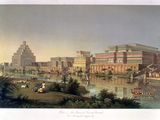What Did the Assyrians Do Once They Rose to Power Again in 1360 Bc
The Assyrian Empire started off as a major regional ability in Mesopotamia in the second millennium B.C.Eastward., merely later on grew in size and stature in the beginning millennium B.C.E. nether a series of powerful rulers, becoming one of the world's earliest empires. Assyria was located in the northern part of Mesopotamia, which corresponds to well-nigh parts of modern-day Iraq as well every bit parts of Islamic republic of iran, Kuwait, Syria, and Turkey. It had relatively humble beginnings equally a nation-land early in the 2d millennium B.C.E. Its condition underwent many changes; though sometimes it was an independent state, it also fell to the Babylonian Empire, and later to Mittani rule. But dissimilar other nation-states, because of their technological advances in warfare, the Assyrians maintained their country while other states and empires rose and barbarous from power. When some other grouping, the Hittites, rose to power and overthrew Mittani rule, it left a power vacuum that sent the region into war and anarchy. This left the Assyrians poised to gain more power in the region. Around 900 B.C.E., a new serial of Assyrian kings, offset with Adad Nirari II, rose to prominence and expanded Assyria's borders into a huge empire. Adad Nirari II and his successors used new warfare techniques to take over enemy cities i by one. The Assyrians had several advantages that they had been developing for generations while other empires came and went. They were the first in the area to develop fe weapons, which were superior to the bronze weapons their enemies were using. Their skill at ironworking allowed them to brand weapons and protective items more cheaply, so more soldiers could utilize them. In improver, they were the first army to have a separate engineering unit, which would gear up upward ladders and ramps, fill up in moats, and dig tunnels to assist the soldiers become into a walled city. They were as well amid the first to build chariots, which provided greater protection on the battleground. These technological advancements allowed the Assyrians to go on the offensive and assault neighboring areas for the first fourth dimension, which led to the expansion of their empire. The Assyrian Empire maintained ability for hundreds of years. But in the 600s B.C.E., the empire became too big to maintain, and it roughshod autonomously. Fifty-fifty later its fall, the empire'due south legacy lived on in the warfare tactics and technologies that were adopted past later civilizations.

The 7th Century Assyrian Male monarch Ashurbanipal built his luxurious palace on the banks of the Tigris River, the main h2o source for the rex and his many subjects in the Assyrian capital of Nimrud.
Photograph by Heritage Images
Assyria
Substantive
(~2500 BCE-609 BCE) kingdom or empire of northern Mesopotamia (what is today parts of Iraq, Syrian arab republic, Turkey, Islamic republic of iran, Kingdom of saudi arabia, and Lebanon) with its capital in Nineveh (what is today Mosul, Iraq).
chariot
Noun
vehicle with 2 or four wheels and pulled past horses.
empire
Noun
group of nations, territories or other groups of people controlled by a single, more powerful authority.
engineering
Noun
the art and scientific discipline of building, maintaining, moving, and demolishing structures.
Mesopotamia
Noun
aboriginal region between the Tigris and Euphrates Rivers, today lying generally in Iraq.
Neo-Babylonian Empire
Substantive
empire in ancient Mesopotamia that existed during the first millennium B.C.Eastward.
successor
Noun
person who comes side by side.
Source: https://www.nationalgeographic.org/encyclopedia/assyrian-empire/
0 Response to "What Did the Assyrians Do Once They Rose to Power Again in 1360 Bc"
Post a Comment